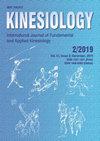高强度间歇运动期间的代谢反应和静息血管和线粒体功能
IF 0.9
4区 医学
Q4 REHABILITATION
引用次数: 0
摘要
高强度功能训练(HIFT)可以在预防心脏代谢疾病中发挥重要作用。大多数HIFT干预包括混合健身(CF)训练。我们测量了参加CF训练的成人的有氧能力、高强度间歇运动(HIIE)期间的代谢反应、静息线粒体氧化能力和静息血管功能(>1年)与久坐组相比,久坐组在1周内完成2小时的结构锻炼。一年(SED)。21名参与者被招募(CF n = 13 vs SED n = 8)。CF参与者的相对VO2峰值高出33.0% (p<.001),体脂率较低(CF = 18.6 [3.8] vs SED = 30.3 [8.4];p&肝移植;措施)。当以绝对和体重相对值表示时,CF参与者有更高的运动底物氧化(p<.013),但当以瘦体重相对值表示时则没有(p>.200)。CF参与者线粒体氧化能力更强(p= 0.014)。大动脉功能没有差异,但CF参与者的基线动脉直径更大(p= 0.004),动脉闭塞后再灌注更快(p< 0.05)。这些数据支持HIFT项目在改善健康、体重状况、代谢、线粒体和血管功能方面的有效性。本文章由计算机程序翻译,如有差异,请以英文原文为准。
Metabolic response during high-intensity interval exercise and resting vascular and mitochondrial function in CrossFit participants
High-intensity functional training (HIFT) can play a major role in preventing cardiometabolic disease. The majority of HIFT interventions incorporate CrossFit (CF) training. We measured aerobic capacity, metabolic response during high-intensity interval exercise (HIIE), resting mitochondrial oxidative capacity, and resting vascular function in adults who participated in CF training (> one year) vs. a sedentary group completing <2 h·wk-1 of structure exercise for > one year (SED). Twenty-one participants were recruited (CF n = 13 vs. SED n = 8). CF participants had a 33.0% greater relative VO2 peak (p<.001) and lower body fat percentage (CF = 18.6 [3.8] vs. SED = 30.3 [8.4]; p<.001). CF participants had higher exercising substrate oxidation when expressed as absolute and body weight relative values (p<.013), but not when expressed relative to lean mass (p>.200). CF participants had greater mitochondrial oxidative capacity (p=.014). There were no differences in large artery function, but CF participants had greater baseline arterial diameter (p=.004) and faster reperfusion following arterial occlusion (p<.05). These data support HIFT programs’ effectiveness in improving fitness, weight status, and metabolic, mitochondrial, and vascular function.
求助全文
通过发布文献求助,成功后即可免费获取论文全文。
去求助
来源期刊

Kinesiology
REHABILITATION-SPORT SCIENCES
CiteScore
1.90
自引率
8.30%
发文量
16
审稿时长
>12 weeks
期刊介绍:
Kinesiology – International Journal of Fundamental and Applied Kinesiology (print ISSN 1331- 1441, online ISSN 1848-638X) publishes twice a year scientific papers and other written material from kinesiology (a scientific discipline which investigates art and science of human movement; in the meaning and scope close to the idiom “sport sciences”) and other adjacent human sciences focused on sport and exercise, primarily from anthropology (biological and cultural alike), medicine, sociology, psychology, natural sciences and mathematics applied to sport in its broadest sense, history, and others. Contributions of high scientific interest, including also results of theoretical analyses and their practical application in physical education, sport, physical recreation and kinesitherapy, are accepted for publication. The following sections define the scope of the journal: Sport and sports activities, Physical education, Recreation/leisure, Kinesiological anthropology, Training methods, Biology of sport and exercise, Sports medicine and physiology of sport, Biomechanics, History of sport and Book reviews with news.
 求助内容:
求助内容: 应助结果提醒方式:
应助结果提醒方式:


